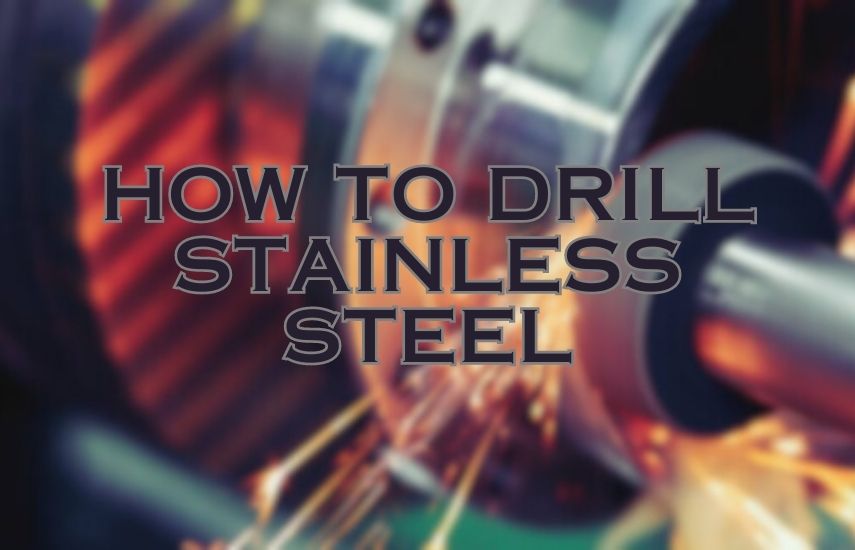If you’re reading this, chances are you’re looking to drill into stainless steel and you’re feeling a bit hesitant about the process.
Perhaps you’ve tried it before and it didn’t turn out quite as you hoped, or maybe you’ve heard horror stories from others who have attempted it. Whatever the reason, drilling into stainless steel can be a daunting task.
To drill stainless steel, start by selecting the appropriate drill bit and lubricating the surface.
Then, apply steady pressure and drill slowly to avoid overheating the metal. Use a coolant to reduce friction and prevent the bit from dulling.
But fear not! With the right tools and techniques, you can successfully drill into this tough metal and achieve the results you desire.
In this blog, we’ll walk you through the steps and offer some tips to help you drill into stainless steel like a pro.
Types of Stainless Steel
Stainless steel is a versatile and durable material that is widely used in various industries such as construction, manufacturing, and transportation.
Not all stainless steel is the same. There are different types of stainless steel that are distinguished by their chemical composition and physical properties.
We will discuss the four main types of stainless steel: Austenitic, Ferritic, Martensitic, and Duplex.
Austenitic Stainless Steel
Austenitic stainless steel is the most commonly used type of stainless steel. It has excellent corrosion resistance, high ductility, and good formability.
This type of stainless steel contains high levels of chromium and nickel, which make it highly resistant to corrosion and oxidation.
Austenitic stainless steel is commonly used in applications where corrosion resistance is critical, such as in the production of chemical, pharmaceutical, and food processing equipment. It is also used in the production of kitchenware, sinks, and automotive parts.
Ferritic Stainless Steel
Ferritic stainless steel is a magnetic type of stainless steel that has a high content of chromium but low levels of nickel.
It has good corrosion resistance and high temperature resistance but is less ductile than austenitic stainless steel.
Ferritic stainless steel is commonly used in applications where heat resistance is critical, such as in the production of exhaust systems, hot water tanks, and furnace parts. It is also used in the production of automotive parts and kitchenware.
Martensitic Stainless Steel
Martensitic stainless steel is a hard and strong type of stainless steel that is commonly used in applications where high strength and corrosion resistance are required.
This type of stainless steel contains high levels of carbon and is heat treatable, which allows it to be hardened and tempered.
Martensitic stainless steel is commonly used in the production of knives, cutting tools, and dental and surgical instruments. It is also used in the production of turbine blades, pump shafts, and valve components.
Duplex Stainless Steel
Duplex stainless steel is a type of stainless steel that has a mixed microstructure of austenitic and ferritic stainless steel. It has high strength, excellent corrosion resistance, and good weldability.
Duplex stainless steel is commonly used in applications where high corrosion resistance is critical, such as in the production of chemical processing equipment, oil and gas pipelines, and marine applications.
Duplex stainless steel is also used in the production of bridges, architectural structures, and storage tanks.
Its unique combination of strength and corrosion resistance makes it an ideal material for challenging environments.
Selecting the Right Tools

Drilling stainless steel can be a challenging task, especially if you are not equipped with the right tools.
Choosing the right tools is important in achieving a clean and precise hole in stainless steel.
We will discuss the essential factors you need to consider when selecting the right tools to drill stainless steel.
Choosing the right drill bit material
When it comes to drilling stainless steel, the type of drill bit material you use can significantly affect the outcome of your project.
For this reason, it is major to select the right drill bit material. High-speed steel (HSS) drill bits are commonly used for drilling stainless steel.
They are durable and can withstand high temperatures, making them ideal for drilling through hard materials like stainless steel.
Another option is cobalt drill bits, which are more expensive but offer better performance and longevity.
Understanding drill bit coatings
Drill bit coatings can enhance the performance of your drill bits and protect them from wear and tear.
For drilling stainless steel, titanium and black oxide coatings are the most commonly used.
Titanium coating offers better wear resistance and helps in reducing friction, while black oxide coating provides additional protection against corrosion and rust.
Selecting the appropriate drill bit size
Choosing the right size of the drill bit is essential in achieving accurate and precise holes in stainless steel.
The size of the hole you want to drill will determine the size of the drill bit you should use. It is essential to select a drill bit that is slightly smaller than the desired hole size to avoid damaging the material or the drill bit.
Using a drill bit size chart can help you determine the appropriate drill bit size for your project.
Importance of using a center punch
Using a center punch is a simple yet effective way to improve the accuracy of your drilling. A center punch creates a small indentation on the surface of the stainless steel, which serves as a guide for the drill bit.
This ensures that the drill bit does not wander off and helps in achieving a more precise and accurate hole.
Make sure to use a center punch that is the same size as the drill bit to ensure the correct placement of the hole. Selecting the right tools is important in drilling stainless steel.
Choosing the right drill bit material, understanding drill bit coatings, selecting the appropriate drill bit size, and using a center punch can significantly improve the accuracy and precision of your drilling. Remember to take your time and use the correct tools to achieve the desired results.
Drilling Techniques and Best Practices
Drilling through stainless steel can be a challenging task due to its hardness and toughness. With the right techniques and equipment, drilling through stainless steel can be done efficiently and effectively. We will discuss some best practices and techniques to help you drill through stainless steel with ease.
Preparing the Workpiece
Before starting to drill, it is essential to prepare the workpiece properly. Using a center punch or a nail, mark the spot where you want to drill.
This will help to create a small indentation on the surface, which will guide the drill bit and prevent it from slipping.
Clamping the workpiece to a stable surface will help to keep it steady and prevent it from moving while drilling.
This will help to produce a cleaner and more accurate hole. Select a drill bit that is specifically designed for drilling through stainless steel. High-speed steel (HSS) or cobalt drill bits are commonly used for this purpose.
Lubrication and Cooling
Lubrication and cooling are critical when drilling through stainless steel. These two processes help to reduce heat build-up and prolong the life of the drill bit. Apply a generous amount of cutting oil to the spot where you want to drill.
This will help to reduce friction, cool down the drill bit, and prevent it from getting dull. If you notice that the drill bit is getting too hot, stop drilling and let it cool down for a few seconds. You can also dip the drill bit in water or cutting oil to cool it down.
Setting the Correct Drilling Speed
The drilling speed is an essential factor when drilling through stainless steel. Here are some tips to help you set the correct drilling speed. Begin drilling at a slow speed to prevent the drill bit from slipping or overheating.
Once you have established a groove, you can increase the speed gradually. Adjust the speed according to the size of the drill bit: Larger drill bits require a slower speed to prevent them from overheating, while smaller drill bits can be used at a higher speed.
Applying Steady and Consistent Pressure
Applying steady and consistent pressure is crucial when drilling through stainless steel. Here are some tips to help you maintain a consistent pressure:
- Use a drill with a variable speed: A drill with a variable speed will allow you to adjust the pressure according to the size of the drill bit and the thickness of the material.
- Use a steady hand: Keep your hand steady and apply a consistent pressure while drilling. Do not push too hard, as this can cause the drill bit to snap or break.
Step by Step Guide

Drilling stainless steel can be a daunting task, especially if you are not familiar with the proper techniques.
However, with the right tools and a bit of knowledge, you can easily drill stainless steel without damaging the material or the drill bit.
Marking the Drilling Location
The first step in drilling stainless steel is to mark the drilling location. To do this, you can use a center punch or a sharpie marker to make a small indentation on the surface of the stainless steel. This will help you guide the drill bit to the right location and prevent it from wandering off.
Creating a Pilot Hole
Next, you will need to create a pilot hole. This is a small hole that will act as a guide for the drill bit and prevent it from wandering off course.
To create a pilot hole, you can use a smaller drill bit than the one you will use for the main hole. Make sure to use a slow speed and apply light pressure when drilling the pilot hole.
Drilling the Main Hole
Once you have created the pilot hole, you can start drilling the main hole. For drilling stainless steel, it is important to use a high-speed steel or cobalt drill bit, as these are more resistant to heat and wear.
You should also use a lubricant, such as cutting oil or WD-40, to cool the drill bit and prevent it from overheating.
Make sure to use a slow speed and apply consistent pressure when drilling the main hole. If you encounter any resistance or the drill bit starts to overheat, stop and apply more lubricant or let the drill bit cool down before continuing.
Finishing and Deburring the Hole
After you have drilled the main hole, you will need to finish and deburr the hole. This involves smoothing out any rough edges or burrs that may have been created during the drilling process. You can use a deburring tool or a file to remove any burrs and create a smooth, clean hole.
Drilling stainless steel requires a bit of patience and attention to detail, but with the right tools and techniques, it can be done easily and efficiently.
Safety Considerations
When it comes to drilling stainless steel, safety should be a top priority. Stainless steel is a hard and durable material, and it can be tricky to work with if proper safety precautions are not taken.
Personal Protective Equipment
Wearing personal protective equipment (PPE) is crucial when drilling stainless steel. PPE helps to protect your eyes, hands, and body from potential hazards that may arise during the drilling process. Here are some PPE items you should consider using when drilling stainless steel:
- Safety glasses or goggles to protect your eyes from metal shavings and debris.
- Heavy-duty work gloves to protect your hands from sharp edges and high temperatures.
- A respirator or dust mask to protect your lungs from harmful dust and fumes.
- A long-sleeved shirt and pants to protect your skin from metal shavings and debris.
Proper Work Area Setup
Setting up your work area correctly is another critical safety consideration when drilling stainless steel. Here are some tips for creating a safe work area:
- Choose a flat and stable surface to work on.
- Ensure that your work area is well-lit and adequately ventilated.
- Keep your work area clean and free of clutter to avoid tripping hazards.
- Keep a fire extinguisher nearby in case of emergencies.
Handling Sharp Tools and Materials
Stainless steel is a hard and durable material, which means that it can be sharp and challenging to work with. Here are some tips for handling sharp tools and materials when drilling stainless steel:
- Use sharp drill bits designed for drilling stainless steel.
- Keep your tools clean and well-maintained to prevent slips and accidents.
- Wear gloves to protect your hands from sharp edges and high temperatures.
- Use a clamp or vice to secure your workpiece and prevent it from moving while drilling.
Safe Disposal of Metal Shavings
Disposing of metal shavings and debris properly is also essential when drilling stainless steel. Here are some tips for safe disposal:
- Use a magnet to collect metal shavings and debris.
- Place metal shavings and debris in a sturdy container with a secure lid.
- Label the container clearly as “Metal Shavings” to avoid confusion with other materials.
- Dispose of the container according to local regulations for hazardous materials.
Conclusion
Congratulations! You have made it to the end of this comprehensive guide on how to drill stainless steel.
By now, you should have a good understanding of the best practices and techniques for drilling this hard and durable material.
We will summarize the key takeaways from the previous sections and provide some additional resources and recommendations to help you achieve success in your stainless steel drilling endeavors.
Whether you are a professional metalworker or a DIY enthusiast, it is essential to approach stainless steel drilling with the right tools, techniques, and mindset.
We have covered several important aspects of this process, including the selection of the appropriate drill bit, the use of lubrication and cooling agents, the proper speed and feed settings, and the precautions to take when working with stainless steel.
By following these guidelines, you can improve your drilling accuracy, reduce the risk of damage to your tools or workpiece, and achieve smoother and cleaner results.
However, it is important to note that drilling stainless steel can still be a challenging task, and there may be some trial and error involved in finding the right approach for your specific project.
In conclusion, drilling stainless steel requires a combination of technical know-how, patience, and practice.
By following the tips and advice outlined, you can increase your chances of success and achieve high-quality results on your drilling projects. Remember to always prioritize safety, be patient, and enjoy the process!









